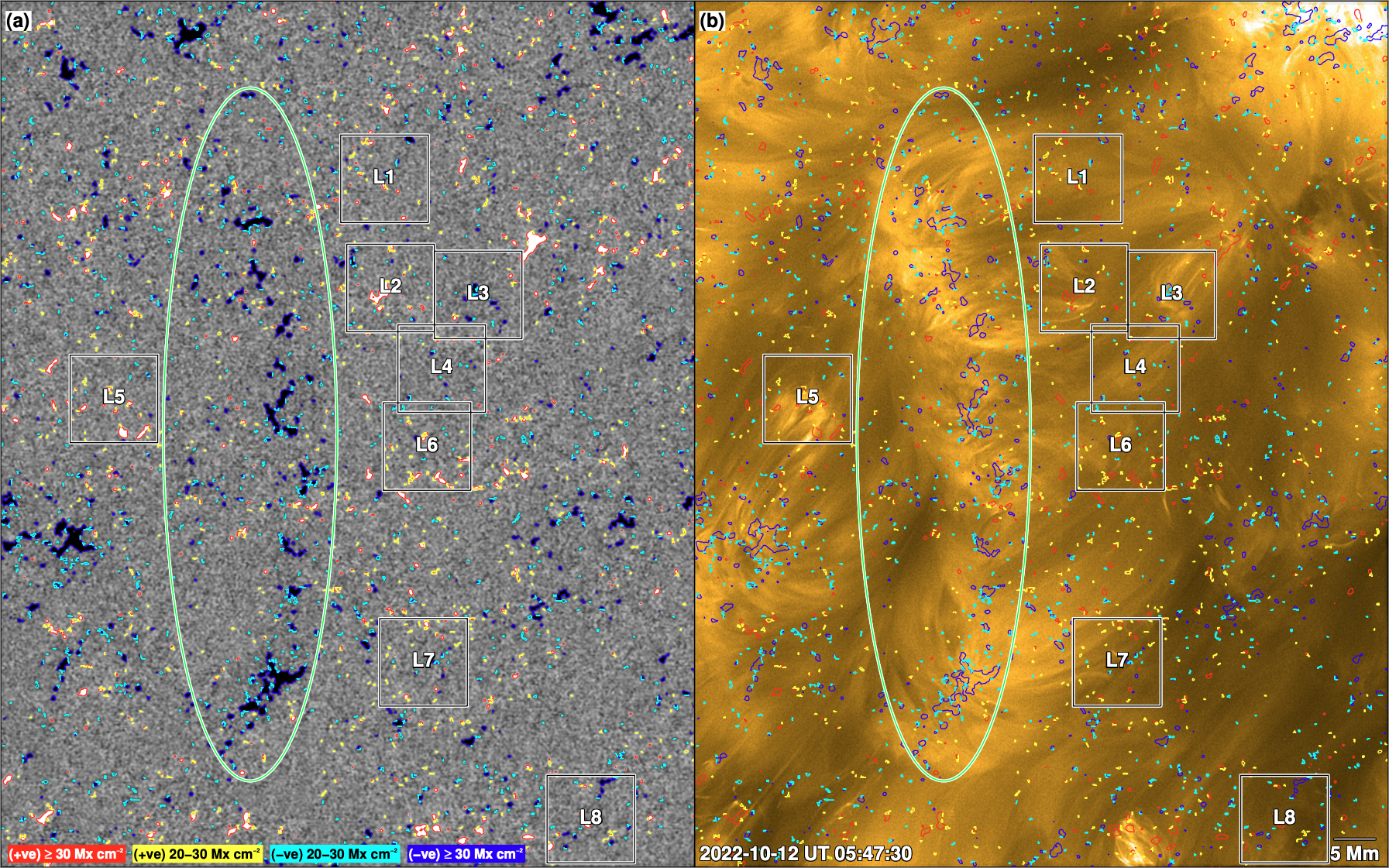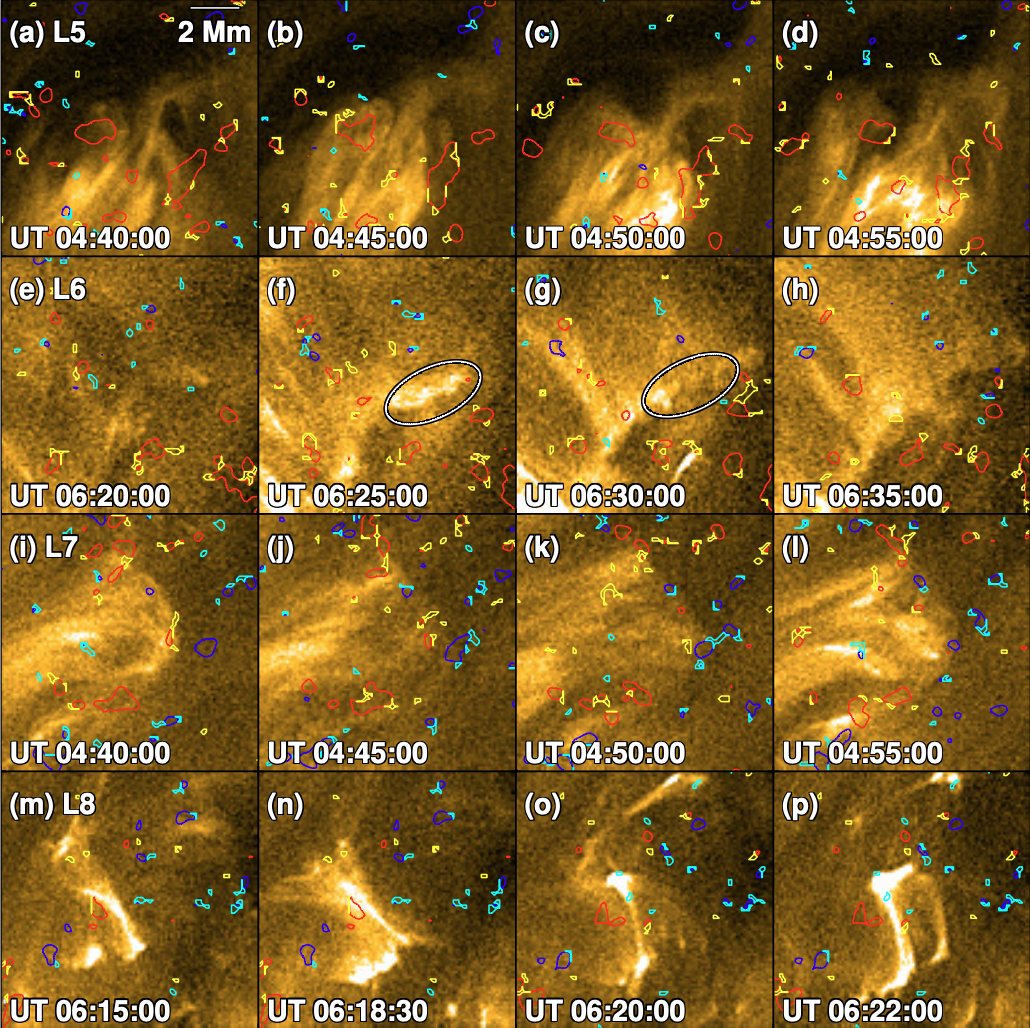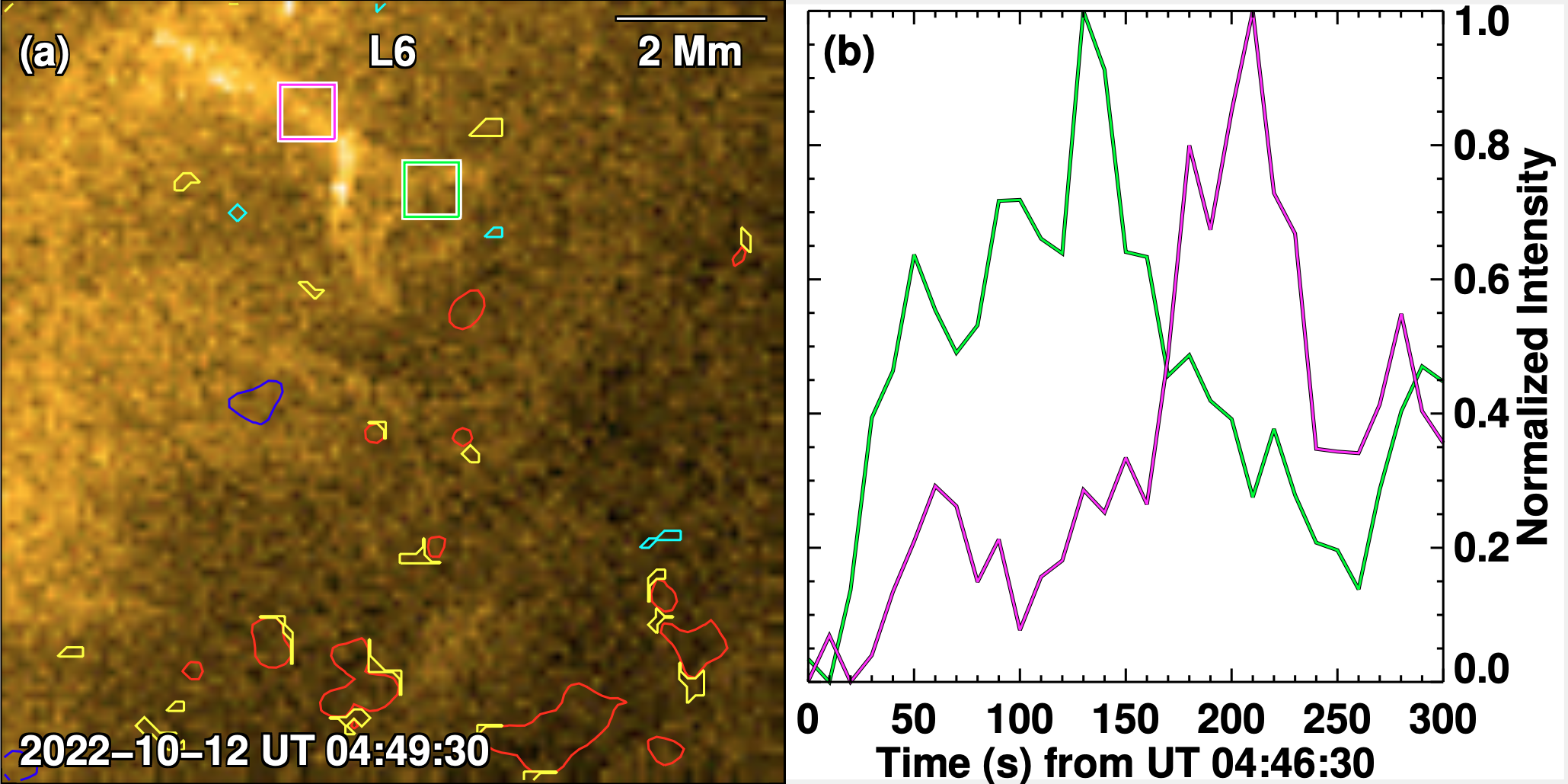Science nugget: Fleeting small-scale surface magnetic fields build the quiet-Sun corona - Solar Orbiter
Fleeting SMALL-SCALE SURFACE MAGNETIC FIELDS BUILD THE QUIET-SUN CORONA
(Solar Orbiter Nugget #18 by L. P. Chitta1, S. K. Solanki1, J. C. del Toro Iniesta2, J. Woch1, D. Calchetti1, A. Gandorfer1, J. Hirzberger1, F. Kahil1, G. Valori1, D. Orozco Suárez2, H. Strecker2, T. Appourchaux3, R. Volkmer4, H. Peter1, S. Mandal1, R. Aznar Cuadrado1, L. Teriaca1, U. Schühle1, D. Berghmans5, C. Verbeeck5, A. N. Zhukov5,6, and E. R. Priest7)
Introduction
The solar corona is built by arch-like loop structures filled with million Kelvin hot plasma. The so-called active corona follows the 11-year solar activity cycle and is governed by strong magnetic concentrations in active regions including sunspots and plages. Powerful flares and coronal mass ejections are some of the transient signatures of the solar activity. Beside these transient active-coronal phenomena, there is a more persistent million Kelvin hot quiet-Sun (QS) corona throughout the solar cycle [1]. It is generally accepted that magnetic fields govern coronal dynamics, however, their role and the details of processes leading to a hot corona remain widely debated [2].
Three-dimensional magnetohydrodynamic (MHD) models do lead to a ∼1 MK hot corona, in which the heating is facilitated via the dissipation of Alfvén waves or through intermittent energy release events from stressed magnetic fields [3,4]. But the correspondence between such MHD models and observations in terms of the quiet-Sun coronal spatial structuring and evolution is not fully established. Underlying the QS corona, photospheric magnetic fields are generally reside on small spatial scales of less than 100 km [5]. Understanding the coupling of such small-scale magnetic fields through the solar atmosphere is crucial to gain better insights into the QS coronal structuring and heating.

Figure 1. Quiet-Sun surface magnetic field elements and the overlying corona. Photospheric magnetic flux density map in a quiet-Sun region close to the disk-center, obtained by SO/PHI on 2022 October 12, is displayed in panel (a). The colored contours outline magnetic field patches with different flux densities as labelled. The overlying coronal loop features captured by the 17.4 nm HRIEUV are shown in panel (b). Boxes L1-L8 mark various coronal loop segments and their photospheric footpoints that we analyzed. The green ellipse covers a prominent magnetic network feature. An animation of Fig. 1b, without the box and ellipse annotations is available below.
Observations
We used photospheric and coronal data obtained from the Solar Orbiter mission [6] to examine the surface magnetic landscape of the quiet-Sun corona. Surface line-of-sight magnetic field maps were recorded by the High-Resolution Telescope (HRT) of the Polarimetric and Helioseismic Imager onboard the Solar Orbiter spacecraft (SO/PHI) [7]. The coronal images, sampling emission around 17.4 nm from ~1MK plasma, were captured by the High-Resolution Imager (HRIEUV) of the Extreme Ultraviolet Imager (EUI) [8] onboard Solar Orbiter. Together, these SO/PHI and HRIEUV observations capture photospheric and coronal magnetic structures at almost exactly the same high spatial resolution of ~210 km (Fig. 1).

Figure 2. Zoom into the magnetic landscape at the base of coronal loops in the quiet Sun. Each row displays a sequence of HRIEUV images, covering loops L5 through L8 as labeled (regions also marked in Fig. 1). Magnetic elements recorded by SO/PHI are outlined by contours (with colors having the same meaning as in Fig. 1).
Magnetic Landscape of the Quiet-Sun Corona
The SO/PHI field of view (FOV) covers small-scale magnetic fields typical of the QS. Based on the estimated rms fluctuations of the magnetic flux density (~10 Mx cm-2), we categorize the magnetic structures into well-detected (red/blue contours) and weaker field (yellow/cyan) patches in Fig. 1a. Magnetic network concentrations (known to host kilo-Gauss flux elements) distributed throughout the FOV, fall in the category of well-detected patches. Weaker field elements generally surround magnetic network concentrations. The overlying coronal EUV emission shows bundles of arch-like loops that are apparently rooted in the underlying network patches (Fig. 1b).
A closer look at the footpoints of a sample of these loop bundles along with the underlying magnetic field structures is displayed in Fig. 2. The surface footpoint regions are bustling with weaker magnetic patches of both positive and negative polarities that evolve on timescales of 5 minutes or less. For instance, the loop bundle L5 apparently ends over a group of well-detected magnetic field concentrations. Still, these elements are flanked by fleeting small-scale mixed-polarity magnetic fields. Loop bundle L6 exhibits mixed-polarity magnetic configuration at its photospheric base, with a brighter portion of it even lacking clear underlying magnetic structures (area outlined by an ellipse in Fig. 2f–g). Similarly, fleeting magnetic field elements are also detected at the base of coronal loop bundles L7 and L8.
We found signatures of weaker small-scale fields at QS coronal loop footpoints playing an active role in coronal dynamics. To this end we detected cases of jet-like eruptive activity emerging from such regions. The example of jet event displayed in Fig. 3 emerging from the L6 region even exhibits a 1–2 Mm wide dome-like structure with an elongated spine feature and the associated propagation of intensity disturbances.
Quiet-Sun coronal loop bundles connected to network magnetic field patches at one end might have their conjugate footpoints rooted in complex weaker and small-scale mixed-polarity magnetic field patches that evolve on timescales of 5 minutes or less. This suggests a continual change of magnetic landscape at the feet of coronal loops.

Figure 3. Coronal disturbances originating from weak-field regions. A snapshot from the HRIEUV sequence covering a small jet feature (marked with green and purple boxes), overlaid with SO/PHI magnetic field contours is displayed in panel (a). The green and purple light curves plotted in panel (b) are average EUV intensities from the respective colored boxes in panel (a).
Implications for the Quiet-Sun Coronal Heating
Poynting flux and wave energy injection into the corona due to these rapidly evolving small-scale features is a missing ingredient in the wave-based heating models [9]. The spatiotemporal variations we observed also indicate that coronal fields might be subjected to rapid tangling and untangling on shorter timescales of only a few 100 s or even less. This has implications for coronal heating models based on dissipation of magnetic braids and currents thought to be induced by slow stressing of footpoints [10]. If the observed magnetic field variations are sustained by frequent surface flux emergence and cancellation events [11], they could energize the overlying corona through magnetic reconnection [12]. Thus, our observational findings have implications for coronal heating models.
Conclusions
High-resolution (~210 km) coordinated observations obtained by SO/PHI and EUI point to an intricate magnetic coupling between the photosphere and the corona. In particular, our study highlights the direct and crucial role of weak and small-scale magnetic fields in the structuring of the million-Kelvin plasma loops in the quiet-Sun corona. Weaker patches of surface magnetic field are observed to evolve rapidly, still coronal disturbances could be identified originating over such fleeting magnetic landscape. Overall, we suggest that magnetic field concentrations with flux content as low as 1015 Mx and/or those that evolve on short timescales of 5 minutes or less are key to structuring and heating of the corona.
This study is published in Chitta. L. P. et al. 2023 ApJL 956 L1. https://doi.org/10.3847/2041-8213/acf136
Movie
Movie 1. Movie corresponding to Fig. 1.
Acknowledgements:
L.P.C. gratefully acknowledges funding by the European Union (ERC, ORIGIN, 101039844).
Affiliations:
1Max-Planck-Institut für Sonnensystemforschung, Justus-von-Liebig-Weg 3, D-37077 Göttingen, Germany
2Instituto de Astrofísica de Andalucía (IAA-CSIC), Apartado de Correos 3004, E-18080 Granada, Spain,
and Spanish Space Solar Physics Consortium (S3PC)
3Univ. Paris-Sud, Institut d’Astrophysique Spatiale, UMR 8617, CNRS, Bâtiment 121, F-91405 Orsay Cedex, France
4Leibniz-Institut für Sonnenphysik, Schöneckstr. 6, D-79104 Freiburg, Germany
5Solar-Terrestrial Centre of Excellence – SIDC, Royal Observatory of Belgium, Ringlaan -3- Av. Circulaire, B-1180 Brussels, Belgium
6Skobeltsyn Institute of Nuclear Physics, Moscow State University, 119991 Moscow, Russia
7School of Mathematics and Statistics, University of St Andrews, St Andrews, KY16 9SS, UK
References
[1] Morgan, H., & Taroyan, Y. 2017 Sci. Adv. 3 e1602056. DOI: 10.1126/sciadv.1602056
[2] Cranmer S. R. and Winebarger A. R. 2019 ARA&A 57 157. DOI: 10.1146/annurev-astro-091918-104416
[3] Amari T., Luciani J.-F. and Aly J.-J. 2015 Nature 522 188. DOI: 10.1038/nature14478
[4] Rempel M. 2017 ApJ 834 10. DOI: 10.3847/1538-4357/834/1/10
[5] Solanki S. K. 1993 SSRv 63 1. DOI: 10.1007/BF00749277
[6] Müller D. et al. 2020 A&A 642 A1. DOI: 10.1051/0004-6361/202038467
[7] Solanki S. K. et al. 2020 A&A 642 A11. DOI: 10.1051/0004-6361/201935325
[8] Rochus P. et al. 2020 A&A 642 A8. DOI: 10.1051/0004-6361/201936663
[9] Van Doorsselaere T. et al. 2020 SSRv 216 140. DOI: 10.1007/s11214-020-00770-y
[10] Parker E. N. 1988 ApJ 330 474. DOI: 10.1086/166485
[11] Smitha H. N. et al. 2017 ApJS 229 17. DOI: 10.3847/1538-4365/229/1/17
[12] Priest E. R., Chitta L. P. and Syntelis P. 2018 ApJL 862 L24. DOI: 10.3847/2041-8213/aad4fc
- Removed a total of (3) style margin:0;
Nuggets archive
2025
09/04/2025: Bursty acceleration and 3D trajectories of electrons in a solar flare
02/04/2025: Picoflare jets in the coronal holes and their link to the solar wind
19/03/2025: Radial dependence of solar energetic particle peak fluxes and fluences
12/03/2025: Analysis of solar eruptions deflecting in the low corona
05/03/2025: Propagation of particles inside a magnetic cloud: Solar Orbiter insights
19/02/2025: Rotation motions and signatures of the Alfvén waves in a fan-spine topology
12/02/2025: 'Sun'day everyday: 2 years of Solar Orbiter science nuggets that shed light on some of our star's mysteries
22/01/2025: Velocity field in the solar granulation from two-vantage points
15/01/2025: First joint X-ray solar microflare observations with NuSTAR and Solar Orbiter/STIX
2024
18/12/2024: Shocks in tandem : Solar Orbiter observes a fully formed forward-reverse shock pair in the inner heliosphere
11/12/2024: High-energy insights from an escaping coronal mass ejection
04/12/2024: Investigation of Venus plasma tail using the Solar Orbiter, Parker Solar Probe and Bepi Colombo flybys
27/11/2024: Testing the Flux Expansion Factor – Solar Wind Speed Relation with Solar Orbiter data
20/11/2024:The role of small scale EUV brightenings in the quiet Sun coronal heating
13/11/2024: Improved Insights from the Suprathermal Ion Spectrograph on Solar Orbiter
30/10/2024: Temporally resolved Type III solar radio bursts in the frequency range 3-13 MHz
23/10/2024: Resolving proton and alpha beams for improved understanding of plasma kinetics: SWA-PAS observations
25/09/2024: All microflares that accelerate electrons to high-energies are rooted in sunspots
25/09/2024: Connecting Solar Orbiter and L1 measurements of mesoscale solar wind structures to their coronal source using the Adapt-WSA model
18/09/2024: Modelling the global structure of a coronal mass ejection observed by Solar Orbiter and Parker Solar Probe
28/08/2024: Coordinated observations with the Swedish 1m Solar Telescope and Solar Orbiter
21/08/2024: Multi-source connectivity drives heliospheric solar wind variability
14/08/2024: Composition Mosaics from March 2022
19/06/2024: Coordinated Coronal and Heliospheric Observations During the 2024 Total Solar Eclipse
22/05/2024: Real time space weather prediction with Solar Orbiter
15/05/2024: Hard X ray and microwave pulsations: a signature of the flare energy release process
01/02/2024: Relativistic electrons accelerated by an interplanetary shock wave
11/01/2024: Modelling Two Consecutive Energetic Storm Particle Events observed by Solar Orbiter
2023
14/12/2023: Understanding STIX hard X-ray source motions using field extrapolations
16/11/2023: EUI data reveal a "steady" mode of coronal heating
09/11/2023: A new solution to the ambiguity problem
02/11/2023: Solar Orbiter and Parker Solar Probe jointly take a step forward in understanding coronal heating
25/10/2023: Observations of mini coronal dimmings caused by small-scale eruptions in the quiet Sun
18/10/2023: Fleeting small-scale surface magnetic fields build the quiet-Sun corona
27/09/2023: Solar Orbiter reveals non-field-aligned solar wind proton beams and its role in wave growth activities
20/09/2023: Polarisation of decayless kink oscillations of solar coronal loops
23/08/2023: A sharp EUI and SPICE look into the EUV variability and fine-scale structure associated with coronal rain
02/08/2023: Solar Flare Hard Xrays from the anchor points of an eruptive filament
28/06/2023: 3He-rich solar energetic particle events observed close to the Sun on Solar Orbiter
14/06/2023: Observational Evidence of S-web Source of Slow Solar Wind
31/05/2023: An interesting interplanetary shock
24/05/2023: High-resolution imaging of coronal mass ejections from SoloHI
17/05/2023: Direct assessment of far-side helioseismology using SO/PHI magnetograms
10/05/2023: Measuring the nascent solar wind outflow velocities via the doppler dimming technique
26/04/2023: Imaging and spectroscopic observations of EUV brightenings using SPICE and EUI on board Solar Orbiter
19/04/2023: Hot X-ray onset observations in solar flares with Solar Orbiter/STIX
12/04/2023: Multi-scale structure and composition of ICME prominence material from the Solar Wind Analyser suite
22/03/2023: Langmuir waves associated with magnetic holes in the solar wind
15/03/2023: Radial dependence of the peak intensity of solar energetic electron events in the inner heliosphere
08/03/2023: New insights about EUV brightenings in the quiet sun corona from the Extreme Ultraviolet Imager








































 Sign in
Sign in
 Science & Technology
Science & Technology